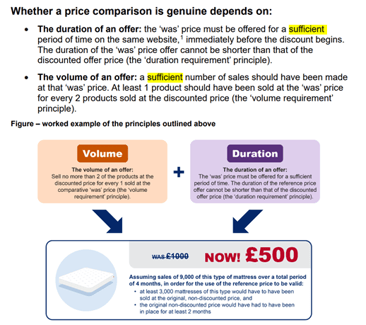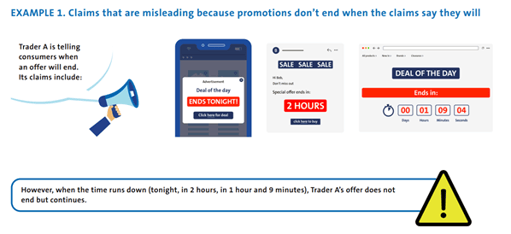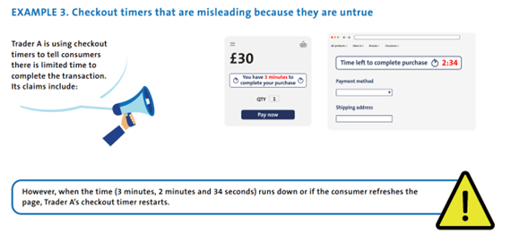Pricing claims, including discount claims, must be clear and fair, and must not mislead consumers. That is the position under consumer protection legislation and the UK’s advertising codes (CAP non-broadcast Code and BCAP broadcast Code).
In August 2024 the Competition & Markets Authority (CMA) issued guidance on reference pricing for online sellers of mattresses. Although this guidance relates to a specific sector, it seems likely that the CMA will follow the same approach to reference prices in other sectors involving online sales of products, except perishable goods, like food and drink.
The CMA focused on:
- the extensive use of potentially misleading price reduction claims, countdown clocks and other urgency claims;
- discount periods which lasted much longer than the time the product was offered at the original ‘was’ price; and
- certain companies selling only very small percentages of mattresses at or above the reference ‘was’ price.
WAS/NOW discount claims and a new “volume” requirement
Was/now claims are common, for example when retailer say that an item was £7.99 and now costs £3.00. These can mislead by omission, if for example the item was only sold at £7.99 for a very short period of time or was originally sold at £2.99 so, £3.99 isn’t exactly cheaper.
The CMA says that when a was/now claim is made:
- the higher ‘was’ price needs to apply for as long as (or longer than) the ‘now’ price (Duration requirement); and
- there must have been a “sufficient number” of sales at the higher “was” price over a sufficient period on the same website immediately before the discount begins (Volume requirement).
The CMA makes clear that both the volume and duration requirements must be met. It is not sufficient for a trader to meet only one of the requirements.
When it comes to the Volume requirement, a ‘sufficient number’ of products must be sold at the higher price. The CMA has applied a 1:2 ratio approach. This means that when making a ‘was/now’ claim, at least one should have been sold at the higher price for every two items sold at the discounted price. This is a new requirement. In the context of mattresses, it was a high bar because the CMA found that companies didn’t sell more than 7.7% of their mattresses at or above the quoted reference prices.
When it comes to the Duration requirement, expanding on the well-established requirement that the ‘was’/’now’ claim should only be used when the ‘was’ price applied for longer than the ‘now’ price, after that time the ‘now’ price becomes the new price, and the ‘was/now’ should not be used. This means that you can carry on charging the lower price, but you must not refer to the previous price or mention that this is a ‘discounted’ price. The CMA said that from a general standpoint, compliance is more likely to be achieved if this period is at least 30 days. However, depending on how the promotion is structured, a shorter period may be sufficient. In the context of Simba Sleep it accepted a price establishment period of 21 days, where the subsequent discount period would be no longer than ten days.

CMA’s guidance to the sector: Discount and reference pricing principles: selling mattresses online (publishing.service.gov.uk)
Urgency claims and countdown clocks
Price claims are often “bunded” with urgency claims or countdown clocks such as “act now, this price is only valid until midnight tonight”. The CMA published more detailed guidance on urgency claims and countdown clocks in March 2023. It considered:
- Claims that are misleading because promotions don’t end when the claims/clocks say they will (the countdown clocks just restart).
- Claims that are misleading because promotions end when the clock stops, but new promotions start on substantially the same basis.
- Misleading timers during checkout (for example ‘Time left to complete your purchase, 04 min 19 sec and counting’), which aren’t necessary/real but are designed to put pressure on consumers to complete their purchase,
- Misleading information in countdown timers or pop-up messages about stock levels (for example, ‘Only 5 items left in stock’),
- Claims creating a false sense of urgency or refer to other unrelated products (e.g. ‘10 people are looking at this item right now, 3 people have it in their basket, only 4 left’; or ‘This product is in high demand! We’ve sold 200 in the past hour! Be quick!’)
If you use this sort of claim, consider if it’s in line with the CMA’s expectations.


Enforcement
To date, the CMA’s approach has been to first investigate certain companies in a particular sector where it believes potentially problematic practices are commonplace, name and shame several of those companies (and issue a public statement about its concerns), elicit undertakings from those companies, and then issue guidance to the industry later.
Under the Digital Markets, Competition and Consumers Act 2024, the CMA can issue unilateral fines of up to 10% of annual global turnover. We expect these powers to be activated in early 2025. Once those powers come into effect the CMA is likely to change its approach to enforcement, because it will be able to issue fines for breaches of undertakings/assurances given to it by any company, as well as any fresh instances of breaches of consumer laws by any company selling to UK consumers, whether they have been previously investigated or not.
With these developments in mind, we would advise that businesses (particularly online retailers) proactively review your practices to check if they are roughly in line with the CMA’s approach, or to consider your strategy.



